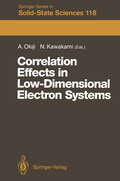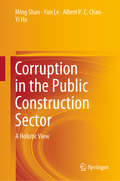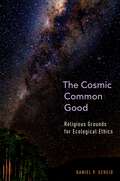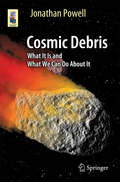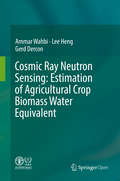- Table View
- List View
Correlated Random Systems: CIRM Jean-MorletChair, Spring 2013 (Lecture Notes in Mathematics #2143)
by Véronique Gayrard Nicola KistlerThis volume presents five different methods recently developed to tackle the large scale behavior of highly correlated random systems, such as spin glasses, random polymers, local times and loop soups and random matrices. These methods, presented in a series of lectures delivered within the Jean-Morlet initiative (Spring 2013), play a fundamental role in the current development of probability theory and statistical mechanics. The lectures were: Random Polymers by E. Bolthausen, Spontaneous Replica Symmetry Breaking and Interpolation Methods by F. Guerra, Derrida's Random Energy Models by N. Kistler, Isomorphism Theorems by J. Rosen and Spectral Properties of Wigner Matrices by B. Schlein.This book is the first in a co-edition between the Jean-Morlet Chair at CIRM and the Springer Lecture Notes in Mathematics which aims to collect together courses and lectures on cutting-edge subjects given during the term of the Jean-Morlet Chair, as well as new material produced in its wake. It is targeted at researchers, in particular PhD students and postdocs, working in probability theory and statistical physics.
Correlation Effects in Low-Dimensional Electron Systems: Proceedings of the 16th Taniguchi Symposium Kashikojima, Japan, October 25–29, 1993 (Springer Series in Solid-State Sciences #118)
by Ayao Okiji Norio KawakamiCorrelation Effects in Low-Dimensional Electron Systems describes recent developments in theoretical condensed-matter physics, emphasizing exact solutions in one dimension including conformal-field theoretical approaches, the application of quantum groups, and numerical diagonalization techniques. Various key properties are presented for two-dimensional, highly correlated electron systems.
Correlation in Hydrocarbon Exploration: Proceedings of the conference Correlation in Hydrocarbon Exploration organized by the Norwegian Petroleum Society and held in Bergen, Norway, 3–5 October 1988
by John CollinsonThis book is the published record of the papers presented at a conference of the Norwegian Petroleum Society (NPF) held in Bergen, Norway, on 3-5 October, 1988. The conference was initially proposed and promoted by the Geology and Geophysics Advisory Committee of the Norwegian Petroleum Society consisting of: A. M. Spencer (Chairman), M. Brink,J. D. Collinson, S. Hanslien, D. M. D.James, T. B. Lund, K. Messel, E. Ormaasen and G. Saeland. The programme and more detailed planning of the conference was carried out by a programme committee consisting of: J. D. Collinson (Chairman), O. Eldholm, E. Holter, D. M. D.James, H. Tykoezinski, D. Worsley and S. M. Aasheim. There were 245 participants at the meeting and 36 papers were presented as talks with a further 9 presented as posters. These proceedings are representative of the range of topics covered. The meeting was characterized by a high level of discussion which has influenced several authors in the final preparation of their written papers. These proceedings have been edi ted on behalf of the Norwegian Petroleum Society by J. D. Collinson with help from H. Tykoezinski. The editor and the organizing committee wish to thank all the referees who reviewed papers and all the authors who responded so fully and promptly to their comments. The NPF is most grateful to the University of Bergen for making available their facilities for the conference.
Correlation of Modelled Atmospheric Deposition of Cadmium, Mercury and Lead with the Measured Enrichment of these Elements in Moss
by Stefan Nickel Winfried Schröder Ilia Ilyin Oleg TravnikovThe book provides a unique analysis of current air pollution in Germany by correlating results from chemical transport modelling and accumulation monitoring by moss.Results of most recent modelling of atmospheric concentration and deposition of the metal elements Cd, Hg and Pb are compared with the results of technical measurements and bioindication with mosses. These modelling results with status 2020 have a higher spatial resolution of 0.1° x 0.1° than the modelling results valid up to then (50 km x 50 km). This leads to partly slightly higher correlations between the findings of the modelling and those of the moss monitoring. In this study, descriptive and correlation-statistical parameters are calculated, results and recommendations drawn described. A statistically adequately deepened analysis and evaluation of the highresolution modelling results requires additional methodological tools, which are outlined in summary. It is particularly important to link the exposure data from modelling, technical measurements and the findings from moss monitoring with information on the receptors, the ecosystem types. This is the only way to ensure that the results of the present project contribute to a more differentiated assessment of the impacts on ecosystems from atmospheric heavy metal deposition than has been the case to date, thus enabling a targeted further development of risk assessments for German
Correlations and Connectivity: Geometric Aspects of Physics, Chemistry and Biology (NATO Science Series E: #188)
by Harry Eugene Stanley N. OstrowskyProceedings of the NATO Advanced Study Institute on Propagation of Correlations in Constrained Systems, Cargèse, Corsica, France, July 2-14, 1990
Correlations, Coherence, and Order
by Diana V. Shopova Dimo I. UzunovThis volume contains a collection of review articles that are extended versions of invited lectures given at the First Pamporovo Winter Workshop on Cooperative Phe nomena in Condensed Matter held in villa "Orlitza" (7th-15th March 1998, Pamporovo Ski Resort, Bulgaria). Selected research works reported at the Workshop have been published in the Journal of Physical Studies - a new International Journal for research papers in experimental and theoretical physics (Lviv University, Lviv, Ukraine). These reviews are supposed to be status reports and present new insights gained from the rapidly developing research of outstanding problems in condensed matter physics such as structural properties and phase transitions in fullerene crystals, super conductivity ofstrongly interacting electrons in copper oxides, spin polarized Fermi liq uids, chaotic vortex filaments in superfluid turbulent Helium-II, desorption induced by electronic transitions in ionic compounds, fluctuation phenomena in superconductors, and quantum critical phenomena in low dimensional magnets and quantum liquids. We have set the material according to the alphabetic order of authors' names although the high temperature superconductivity seems to be the hard kernel in condensed matter physics. The authors have taken care to present the recent advances in their research in a form which is readable and useful not only to experts in the respective field, but also to young scientists. That is why the lectures include a comprehensive introduction to the matter and also an extended discussion of methodical details.
Correlations in Low-Dimensional Quantum Gases (Springer Theses)
by Guillaume LangThe book addresses several aspects of thermodynamics and correlations in the strongly-interacting regime of one-dimensional bosons, a topic at the forefront of current theoretical and experimental studies. Strongly correlated systems of one-dimensional bosons have a long history of theoretical study. Their experimental realisation in ultracold atom experiments is the subject of current research, which took off in the early 2000s. Yet these experiments raise new theoretical questions, just begging to be answered. Correlation functions are readily available for experimental measurements. In this book, they are tackled by means of sophisticated theoretical methods developed in condensed matter physics and mathematical physics, such as bosonization, the Bethe Ansatz and conformal field theory. Readers are introduced to these techniques, which are subsequently used to investigate many-body static and dynamical correlation functions.
Correlations of Soil and Rock Properties in Geotechnical Engineering (Developments in Geotechnical Engineering)
by Jay Ameratunga Nagaratnam Sivakugan Braja M. DasThis book presents a one-stop reference to the empirical correlations used extensively in geotechnical engineering. Empirical correlations play a key role in geotechnical engineering designs and analysis. Laboratory and in situ testing of soils can add significant cost to a civil engineering project. By using appropriate empirical correlations, it is possible to derive many design parameters, thus limiting our reliance on these soil tests. The authors have decades of experience in geotechnical engineering, as professional engineers or researchers. The objective of this book is to present a critical evaluation of a wide range of empirical correlations reported in the literature, along with typical values of soil parameters, in the light of their experience and knowledge. This book will be a one-stop-shop for the practising professionals, geotechnical researchers and academics looking for specific correlations for estimating certain geotechnical parameters. The empirical correlations in the forms of equations and charts and typical values are collated from extensive literature review, and from the authors' database.
Corruption in the Public Construction Sector: A Holistic View
by Ming Shan Yun Le Albert P.C. Chan Yi HuThis book is committed to provide a holistic view of corruption in the public construction sector, a sector that has been perceived as the most corrupt in the world. Relying on the new findings achieved from a series of qualitative and quantitative studies, this book unveils the specific forms of corruption, the principal causes of corruption, and the prevailing anti-corruption strategies that are used by the current practice. Furthermore, this book provides two metrics that can assess the potential of corruption and the risk of collusion in given public construction projects, respectively. This book will enhance industry and research communities’ understandings of corruption in the public construction sector. It is also informative to policy-makers and can help them come up with some more effective strategies to eliminate corruption in the public construction sector.
Coseismic Landslides: Phenomena, Long-Term Effects and Mitigation (Springer Natural Hazards)
by Ikuo Towhata Gonghui Wang Qiang Xu Chris MasseyThis book is the result of an elaborate project initiated by the Joint Technical Committee (JTC-1) of 1) the International Society for Soil Mechanics and Geotechnical Engineering, 2) the International Association for Engineering Geology and the Environment, 3) the International Society for Rock Mechanics, and 4) the International Geotextile Society, with the focus on natural slopes and landslides. The framework of the book sets out the steps, based on recent disaster experiences in the twenty-first century, leading to the assessment of earthquake-induced landslide hazards. It contains: 1) important cases of landslides triggered by earthquakes around the world; 2) investigation into the characteristics of ground motion site response; 3) methods to determine landslide susceptibility and triggering thresholds and their comparative study; and 4) commentary on the production of earthquake-induced landslide hazard maps. All the contents are the result of the latest research on related areas. The book is a valuable resource for researchers, designers, consultants, academicians, government officials, and all others who are involved in the mitigation of coseismic landslides. The book contributes toward the development of a new chapter in disaster prevention and mitigation of landslides induced by earthquakes.
Cosmic Chemistry (Reviews in Modern Astronomy #1)
by Gerhard KlareThe annual meeting of the Astronomische Gesellschaft in Cologne, June 1988, featured extensive reviews of the chemical processes relevant to astrophysics. The twelve contributions to this book, written by experts from the US, UK, France, Belgium, Switzerland and Germany, deal in depth with the chemistry of comets and meteorites, of stars and their shells, of the interstellar medium and galaxies. A comprehensive review of nucleosynthesis and two reports on observations round off an up-to-date presentation of cosmic chemistry.
The Cosmic Common Good: Religious Grounds for Ecological Ethics
by Daniel P. ScheidAs ecological degradation continues to threaten permanent and dramatic changes for life on our planet, the question of how we can protect our imperiled Earth has become more pressing than ever before. In this book, Daniel Scheid draws on Catholic social thought to construct what he calls the "cosmic common good," a new norm for interreligious ecological ethics. This ethical vision sees humans as an intimate part of the greater whole of the cosmos, emphasizes the simultaneous instrumental and intrinsic value of nature, and affirms the integral connection between religious practice and the pursuit of the common good. When ecologically reoriented, Catholic social thought can point the way toward several principles of the cosmic common good, such as the virtue of Earth solidarity and the promotion of Earth rights. These are rooted in the classical doctrines of creation in Augustine and Thomas Aquinas, and in Thomas Berry's interpretation of the evolutionary cosmic story. The cosmic common good can also be found in Hindu, Buddhist, and American Indian religious traditions. By placing a Catholic cosmic common good in dialogue with Hindu dharmic ecology, Buddhist interdependence, and American Indian balance with all our relations, Scheid constructs a theologically authentic moral framework that re-envisions humanity's role in the universe.
The Cosmic Common Good: Religious Grounds for Ecological Ethics
by Daniel P. ScheidAs ecological degradation continues to threaten permanent and dramatic changes for life on our planet, the question of how we can protect our imperiled Earth has become more pressing than ever before. In this book, Daniel Scheid draws on Catholic social thought to construct what he calls the "cosmic common good," a new norm for interreligious ecological ethics. This ethical vision sees humans as an intimate part of the greater whole of the cosmos, emphasizes the simultaneous instrumental and intrinsic value of nature, and affirms the integral connection between religious practice and the pursuit of the common good. When ecologically reoriented, Catholic social thought can point the way toward several principles of the cosmic common good, such as the virtue of Earth solidarity and the promotion of Earth rights. These are rooted in the classical doctrines of creation in Augustine and Thomas Aquinas, and in Thomas Berry's interpretation of the evolutionary cosmic story. The cosmic common good can also be found in Hindu, Buddhist, and American Indian religious traditions. By placing a Catholic cosmic common good in dialogue with Hindu dharmic ecology, Buddhist interdependence, and American Indian balance with all our relations, Scheid constructs a theologically authentic moral framework that re-envisions humanity's role in the universe.
Cosmic Debris: What It Is and What We Can Do About It (Astronomers' Universe)
by Jonathan PowellThis book examines the mysterious and the well-studied debris in Earth’s crowded neighborhood. From orbiting comets to the workings of the Asteroid Belt, and from meteor showers to our home-grown network of orbiting satellites, the full diversity of space objects and the debris they create is explored. Powell also discusses some of the current research techniques used to find potentially harmful rogue elements, with an emphasis on keeping watch for any objects that may intersect Earth’s orbit. Such bodies also impact other worlds, and much has been learned from observing these encounters.The information in this book is intended to foster thought about the universe in which we live, but without overloading its readers with numbers and lecture-room analysis. Like a good thriller, it allows its readers to pace themselves with the story and, by the end, encourages them to draw their own conclusions.
Cosmic Electrodynamics: Electrodynamics and Magnetic Hydrodynamics of Cosmic Plasmas (Astrophysics and Space Science Library #388)
by Gregory D. Fleishman Igor N. ToptyginThis book presents the fundamental concepts of the theory, illustrated by numerous examples of astrophysical applications. Classical concepts are combined with new developments and the authors demarcate what is well established and what is still under debate. To book illustrates how apparently complicated phenomena can be addressed and understood using well-known physical principles and equations within appropriate approximations and simplifications. For this purpose, a number of astrophysical examples are considered in greater detail than what is normally presented in a regular textbook. In particular, a number of nonlinear self-consistent models are considered, which is motivated by the latest observational data and modern theory.
The Cosmic Keyhole: How Astronomy Is Unlocking the Secrets of the Universe (Astronomers' Universe)
by Will GaterIn the last thirty years humans have probed the Universe, explored the Solar System and visited with spacecraft some of the most incredible places humans have ever laid eyes upon. We have expanded our knowledge slowly and surely, but still now only see a glimpse of the bigger picture. The Cosmic Keyhole explores the big discoveries of recent years and asks what’s next? How prolific is life in the Universe? How far back to the Big Bang can we probe? And what hidden treasures still await us in the hidden corners of our Solar System?
Cosmic Plasma Physics (Astrophysics and Space Science Library #251)
by B.V. SomovThis unusual book considers physical principles, starting from the most general ones, and simplifies assumptions, helping students answer two key questions: what approximation is the simplest, but still sufficient for the description of a phenomenon in cosmic plasmas, and how to build an adequate model.
Cosmic Radiations: From Astronomy to Particle Physics (NATO Science Series II: Mathematics, Physics and Chemistry #42)
by Giorgio Giacomelli Maurizio Spurio Jamal Eddine DerkaouiNon-accelerator particle physicists, especially those studying neutrino oscillation experiments, will read with profit the in-depth discussions of new results and their interpretations. new guidelines are also set out for new developments in this and related fields. Discussions are presented of neutrino oscillations, neutrino astronomy, high energy cosmic rays, gravitational waves, magnetic monopoles and dark matter. The future large-scale research projects discussed include the experiments on long baseline neutrino beams from CERN to Gran Sasso and Fermilab to the Soudan mine; large underwater and under-ice experiments; the highest energy cosmic rays; gravitational waves; and the search for new particles and new phenomena.
Cosmic Ray Diffusion in the Galaxy and Diffuse Gamma Emission (Springer Theses)
by Daniele GaggeroThe original work presented in this thesis constitutes an important contribution to modern Cosmic Ray (CR) physics, and comes during one of the most exciting periods of this field. The first part introduces a new numerical code (DRAGON) to model the CR propagation in our Galaxy. The code is then used to perform a combined analysis of CR data, making it possible to determine their propagation properties with unprecedented accuracy. The second part is dedicated to a theoretical interpretation of the recent crucial experimental results on cosmic electron and positron spectra (PAMELA, Fermi-LAT experiments). Using the tools developed in the first part of the thesis, the author convincingly argues for the existence of a new spectral component, which could arise either from local astrophysical sources, such as pulsars, or from Dark Matter annihilation or decay. This thesis is a highly advanced work; the methods, analysis and results are clearly and carefully presented. This work is set to become an important reference document for any future work in this area.
Cosmic Ray Neutron Sensing: Estimation of Agricultural Crop Biomass Water Equivalent
by Ammar Wahbi Lee Heng Gerd DerconThis open access book provides methods for the estimation of Biomass Water Equivalent (BEW), an essential step for improving the accuracy of area-wide soil moisture by cosmic-ray neutron sensors (CRNS). Three techniques are explained in detail: (i) traditional in-situ destructive sampling, (ii) satellite based remote sensing of plant surfaces, and (iii) biomass estimation via the use of the CRNS itself. The advantages and disadvantages of each method are discussed along with step by step instructions on proper procedures and implementation.
Cosmic Rays: Multimessenger Astrophysics and Revolutionary Astronomy (Astronomers' Universe)
by Alessandro De AngelisIn recent years, cosmic rays have become the protagonists of a new scientific revolution. We are able today to film the Universe with telescopes of completely novel conception, recording information from many different messengers and accessing previously unknown cosmic regions.Written by a recognized authority in physics, this book takes readers on a captivating journey through the world of cosmic rays, their role in the revolutionary field of multi-messenger astronomy, their production from powerful accelerators close to the surfaces of black holes and compact objects, reaching the highest levels of energy observed in nature, and the implications this has for our understanding of the Universe. Through the stories of pioneering scientists, explorations of cutting-edge technologies, and simple explanations related to particle physics, quantum mechanics, and astrophysics, the book provides an illuminating state-of-the-art introduction to the current state of high-energy astrophysics. The book was written in straightforward yet rigorous language, so as to be accessible to the greater public. For those curious about the cosmos and cosmic gamma rays, nuclei, neutrinos, and gravitational waves, from casual observers to professional astronomers and physicists, the book is a must-read, offering a thrilling adventure into the future of astronomy and particle physics.
Cosmic Rays in Magnetospheres of the Earth and other Planets (Astrophysics and Space Science Library #358)
by Lev DormanThe problem of cosmic ray (CR) geomagnetic effects came to the fore at the beg- ning of the 1930s after the famous expeditions by J. Clay onboard ship (Slamat) between the Netherlands and Java using an ionization chamber. Many CR la- tude expeditions were organized by the famous scientists and Nobel Laureates R. Millikan and A. Compton. From the obtained latitude curves it follows that CRs cannot be gamma rays (as many scientists thought at that time), but must be charged particles. From measurements of azimuthally geomagnetic effect at that time it also followed that these charged particles must be mostly positive (see Chapter 1, and for more details on the history of the problem see monographs of Irina Dorman, M1981, M1989). The ?rst explanations of obtained results were based on the simple dipole - proximation of the geomagnetic ?eld and the theory of energetic charged particles moving in dipole magnetic ?elds, developed in 1907 by C. Stormer ¨ to explain the aurora phenomenon. Let us note that it was made about 5 years before V. Hess discovered CRs, and received the Nobel Prize in 1936 together with K. Anderson (for the discovery of CR and positrons in CR).
Cosmic Rays in the Earth’s Atmosphere and Underground (Astrophysics and Space Science Library #303)
by Lev DormanThe present monograph as well as the next one (Dorman, M2005) is a result of more than 50 years working in cosmic ray (CR) research. After graduation in December 1950 Moscow Lomonosov State University (Nuclear and Elementary Particle Physics Division, the Team of Theoretical Physics), my supervisor Professor D. I. Blokhintsev planned for me, as a winner of a Red Diploma, to continue my education as an aspirant (a graduate student) to prepare for Ph. D. in his very secret Object in the framework of what was in those time called the Atomic Problem. To my regret the KGB withheld permission, and I, together with other Jewish students who had graduated Nuclear Divisions of Moscow and Leningrad Universities and Institutes, were faced with a real prospect of being without any work. It was our good fortune that at that time there was being brought into being the new Cosmic Ray Project (what at that time was also very secret, but not as secret as the Atomic Problem), and after some time we were directed to work on this Project. It was organized and headed by Prof. S. N. Vernov (President of All-Union Section of Cosmic Rays) and Prof. N. V. Pushkov (Director of IZMIRAN); Prof. E. L. Feinberg headed the theoretical part of the Project.
Cosmic Update: Dark Puzzles. Arrow of Time. Future History (Multiversal Journeys)
by Fred Adams Thomas Buchert Laura Mersini-Houghton"...The Multiversal book series is equally unique, providing book-length extensions of the lectures with enough additional depth for those who truly want to explore these fields, while also providing the kind of clarity that is appropriate for interested lay people to grasp the general principles involved." - Lawrence M. KraussCosmic Update Covers:A novel approach to uncover the dark faces of the Standard Model of cosmology.The possibility that Dark Energy and Dark Matter are manifestations of the inhomogeneous geometry of our Universe.On the history of cosmological model building and the general architecture of cosmological modes.Illustrations on the Large Scale Structure of the Universe.A new perspective on the classical static Einstein Cosmos.Global properties of World Models including their Topology.The Arrow of Time in a Universe with a Positive Cosmological Constant.Exploring the consequences of a fundamental Cosmological Constant for our Universe. Exploring why the current observed acceleration of the Universe may not be its final destiny.Demonstrating that nature forbids the existence of a pure Cosmological Constant.Our current understanding of the long term (in time scales that greatly exceed the current age of the Universe) future of the Universe.The long term fate and eventual destruction of the astrophysical objects that populate the universe -- including clusters, galaxies, stars, planets, and black holes. The material is presented in a layperson-friendly language followed by addition technical sections that explain the basic equations and principles. This feature is very attractive to readers who want to learn more about the theories involved beyond the basic description. "Multiversal Journeys™ is a trademark of Farzad Nekoogar and Multiversal Journeys, a 501 (c) (3) nonprofit organization."
The Cosmic Zoo: Complex Life on Many Worlds
by Dirk Schulze-Makuch William BainsAre humans a galactic oddity, or will complex life with human abilities develop on planets with environments that remain habitable for long enough? In a clear, jargon-free style, two leading researchers in the burgeoning field of astrobiology critically examine the major evolutionary steps that led us from the distant origins of life to the technologically advanced species we are today. Are the key events that took life from simple cells to astronauts unique occurrences that would be unlikely to occur on other planets? By focusing on what life does - it's functional abilities - rather than specific biochemistry or anatomy, the authors provide plausible answers to this question. Systematically exploring the various pathways that led to the complex biosphere we experience on planet Earth, they show that most of the steps along that path are likely to occur on any world hosting life, with only two exceptions: One is the origin of life itself – if this is a highly improbable event, then we live in a rather “empty universe”. However, if this isn’t the case, we inevitably live in a universe containing a myriad of planets hosting complex as well as microbial life - a “cosmic zoo”. The other unknown is the rise of technologically advanced beings, as exemplified on Earth by humans. Only one technological species has emerged in the roughly 4 billion years life has existed on Earth, and we don’t know of any other technological species elsewhere. If technological intelligence is a rare, almost unique feature of Earth's history, then there can be no visitors to the cosmic zoo other than ourselves. Schulze-Makuch and Bains take the reader through the history of life on Earth, laying out a consistent and straightforward framework for understanding why we should think that advanced, complex life exists on planets other than Earth. They provide a unique perspective on the question that puzzled the human species for centuries: are we alone?

